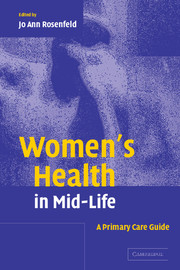Book contents
- Frontmatter
- Contents
- List of contributors
- 1 Introduction
- Part I Health promotion
- 2 Physical activity and exercise
- 3 Nutrition
- 4 Psychosocial health promotion of mid-life women
- 5 Sexual health
- 6 Alcoholism, nicotine dependence, and drug abuse
- 7 Depression and anxiety
- Part II Hormonal changes
- Part III Disease prevention
- Part IV Cancer prevention
- Index
- References
5 - Sexual health
from Part I - Health promotion
Published online by Cambridge University Press: 21 August 2009
- Frontmatter
- Contents
- List of contributors
- 1 Introduction
- Part I Health promotion
- 2 Physical activity and exercise
- 3 Nutrition
- 4 Psychosocial health promotion of mid-life women
- 5 Sexual health
- 6 Alcoholism, nicotine dependence, and drug abuse
- 7 Depression and anxiety
- Part II Hormonal changes
- Part III Disease prevention
- Part IV Cancer prevention
- Index
- References
Summary
Case: a 50 year-old woman presents for her wellness exam. She has no chronic illnesses or allergies, and she is on no medications. She is married, has five children, and has not worked outside of the home since she was married at age 22. Her review of systems is remarkable for tearfulness and occasional feelings of “nervousness.” The youngest, and last of her five children to leave home, leaves for college in ten days.
Importance
Sexuality and sexual health are some of the least scientifically studied areas of health and human interaction, and the sexual health of mid-life women is no exception.
Sexuality is much more then sexual behavior. Sexuality is an important part of one's health, quality of life, and general wellbeing. Sexuality is an integral part of the total person, affecting the way each individual – from birth to death – relates to herself, her sexual partner(s), and every other person. This time of life can and should be a tremendously positive time for women in regards to sexual health. How a woman successfully navigates sexual health risks depends on the complexity of how she defines herself and her sexuality in relationship to aging, menstruation, childbearing capability, success with overcoming challenges of her past, and the quality of intimate partnership(s). Risks to sexual health can include unplanned pregnancy, the physiologic changes of transition into and through menopause and with aging, the increased probability of chronic illness and its medical and surgical treatment, abuse in any form, and sexually transmitted infections.
Keywords
- Type
- Chapter
- Information
- Women's Health in Mid-LifeA Primary Care Guide, pp. 61 - 80Publisher: Cambridge University PressPrint publication year: 2004

